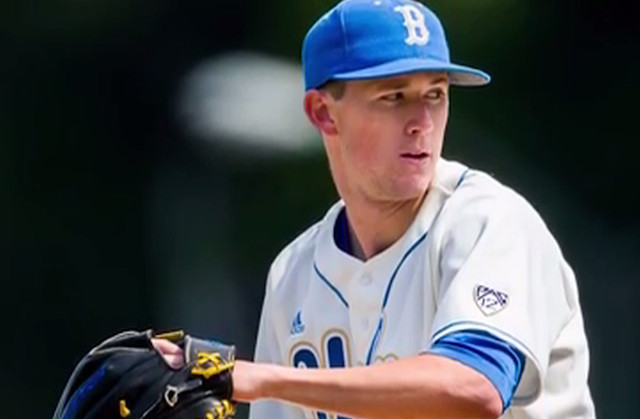
Tanner Houck, RHP, Missouri | B/T: R/R
Scouting Consensus: Listed at 6’5 and 215 lbs. Big, physical frame. Fastball sits in the low 90s, touches the mid 90s. Has a lot of movement on pitches due to his low arm slot. Slider could be an out pitch.
Jared’s Take: Stuff backed up late this spring and has caused his stock to drop. Concerns over Houck’s arm slot lead to questions if he can stay in a rotation. Higher ceiling/lower floor than Canning and Peterson.
Risk: Medium-high. The downtick in his stuff combined with the questions about his future as a starter make Houck a volatile prospect.
Availability: Medium-high. Struggled at the end of the season. Should be available in the 20s.
Outlook: Probably too much risk to draft 23rd overall. Could go higher, but with other options likely available, I’d pass.
Nate Pearson, RHP, College of Central Florida | B/T: R/R
Scouting Consensus: Listed at 6’5, 240 lbs. Huge frame. Fastball in the mid 90s. Developing slider. Command and secondaries need development.
Jared’s Take: Recently touched 101 mph in a bullpen session. If a team falls in love with the frame and arm strength, Pearson could go in the 20s.
Risk: Medium-high. There’s a good chance he ends up in the bullpen and/or the secondary pitches don’t come around.
Availability: Medium-high. While the recent bullpen session could push Pearson up draft boards, he’s still very likely to be there at No. 23.
Outlook: High ceiling/low floor guy. A team that has had success developing pitchers could take a chance on him. Ways away from the Majors.
Brendon Little, LHP, State College of Florida | B/T: L/L
Scouting Consensus: Listed at 6’2, 195 lbs. Transferred from North Carolina. Broke out in the Cape Cod League. Power fastball up to 97 mph. Power curve with a 12-6 break. Still developing his changeup. Command and delivery need refinement.
Jared’s Take: Another hard-throwing junior college arm from Florida. Comes with a good curve and an iffy delivery. Looks like the delivery’s been cleaned up a little this year, which is promising for his future command profile.
Outpitched Pearson in a head-to-head matchup in February, tallying 10 strikeouts in five innings.
Risk: Medium. The fastball and curve should get Little to the Majors. Ultimate question is, rotation or bullpen?
Availability: High. Would be an overdraft at No. 23. Interesting target for an overslot deal at the Dodgers’ No. 62 overall pick.
Outlook: Doesn’t make a ton of sense at No. 23 unless the Dodgers see something other teams don’t. Like Pearson, high ceiling/low floor type who will need some years in the Minors to develop.
Scouting Glossary
Scouts and evaluators have a shorthand for explaining how good certain tools are. It starts at Average, or 50 on the 20-80 scale, and has three standard deviations in each direction. Here are examples:
80 – Elite | Almost never given out to prospects, still rare among Major Leaguers. Think Clayton Kershaw’s curveball or Yasiel Puig’s arm strength.
70 – Plus-plus | Still rare, but more common than 80s. Think Justin Turner’s defense or Rich Hill’s curveball.
60 – Plus | Pretty common among prospects and Major Leaguers alike. Think Corey Seager’s arm strength or Kenta Maeda’s slider.
50 – Average | The most common grade. Think Corey Seager’s speed or Maeda’s fastball.
40 | There really isn’t a name for 40 grades, they’re just 40s. Think Joc Pederson’s speed or Seager’s defense.
30 – Poor | Even rarer. Think Puig’s plate discipline or Kershaw’s changeup.
20 – Bad | It’s not really identified as “Bad” but it should be. Think Chase Utley’s arm, Adrian Gonzalez’s speed and Pedro Baez’s pace of play.
Scouting consensus culled from MLB.com, FanGraphs, Baseball America and other sites. Video courtesy of Steve Fiorindo of The Prospect Pipeline, The Prospect Lab and MaxPreps.
You can listen to Jared on the weekly Dugout Blues Podcast








